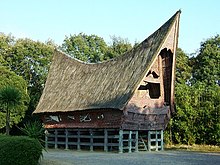Rumah adat
From Wikipedia, the free encyclopedia

Traditional house in Nias; its post, beam and lintel construction with flexible nail-less joints, and non-load bearing walls are typical of rumah adat
General form
With few exceptions, the peoples of the Indonesian archipelago share a common Austronesian ancestry (originating in Taiwan, c. 6,000 years ago[3]), and traditional homes of Indonesia share a number of characteristics such as timber construction, varied and elaborate roof structures.[3] The earliest Austronesian structures were communal longhouses on stilts, with steep sloping roofs and heavy gables, as seen in the Batak rumah adat and the Torajan Tongkonan.[3] Variations on the communal longhouse principle are found among the Dayak people of Borneo, as well as the Mentawai people.[3]
A traditional Batak Toba house in North Sumatra

A fishing village of pile houses in the Riau archipelago
Traditional dwellings have developed to respond to natural environmental conditions, particularly Indonesia's hot and wet monsoon climate. As is common throughout South East Asia and the South West Pacific, most rumah adat are built on stilts, with the exception of Java and Bali.[1] Building houses off the ground on stilts serve a number of purposes: it allows breezes to moderate the hot tropical temperatures; it elevates the dwelling above stormwater runoff and mud; it allows houses to be built on rivers and wetland margins; it keeps people, goods and food from dampness and moisture; lifts living quarters above malaria-carrying mosquitos; and reduces the risk of dry rot and termites.[5] The sharply inclined roof allows the heavy tropical rain to quickly sheet off, and large overhanging eaves keep water out of the house and provide shade in the heat.[6] In hot and humid low-lying coastal regions, homes can have many windows providing good cross-ventilation, whereas in cooler mountainous interior areas, homes often have a vast roof and few windows.[2]

Contemporary vernacular architecture can be contrasted with elite or complimentary architecture that is characterized by aesthetic design elements deliberately incorporated for aesthetic purposes that go beyond the functional requirements of a building.
BalasHapus